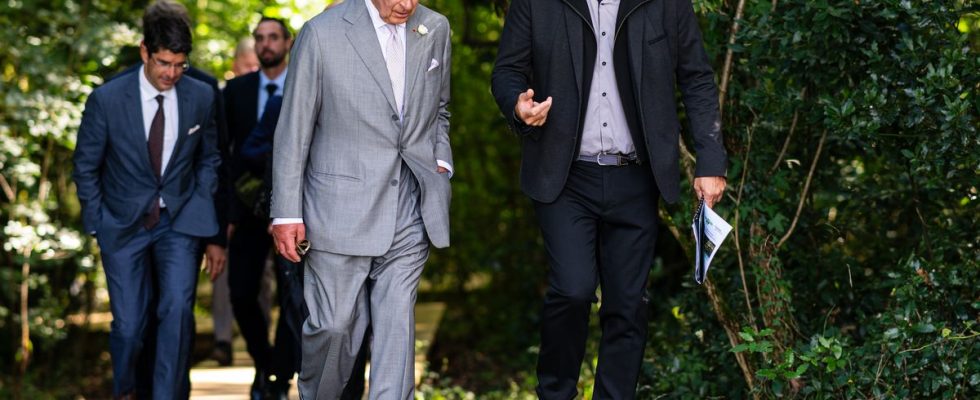Sensitive to issues of global warming and organic farming, King Charles III made the environment the central theme of his visit to Bordeaux on Friday. Among the sites visited by his highness was the “experimental forest” of Floirac. This is a research project carried out by scientists from the University of Bordeaux and INRAE (National Institute of Agricultural Research), whose exact title is FORLand, “forest for the earth”. Its objective is to study the response of forests to climate change in order to be able to adapt it and help fight against global warming. 20 minutes questioned Sylvain Delzon, Biogeco research director (Biodiversity, Genes and Community) for Inrae – University of Bordeaux.
How did King Charles III’s visit to the FORLand site go on Friday?
The visit went very well, even though it only lasted forty-five minutes. We were able to discuss the adaptation of forests to climate change, and in particular the recent dieback observed during droughts and fires, which have in common the release of an enormous amount of CO2 into the atmosphere. The goal of our work is to find solutions to adapt these forests, in order to avoid these types of extreme events as much as possible, in particular these major fires that we experienced in 2022 in the South-West, or this year in Canada. We also discussed at length the mechanisms explaining tree mortality during droughts, which are mechanisms of vascular embolism of the tree. We had installed a live experiment, where he was able to see on screens what happens inside the tree when there is a severe drought, with the appearance of air bubbles in the tree. vascular apparatus, which replace the sap.
Is this a long-known phenomenon?
There has undoubtedly always been some, but we have only been able to observe it for three or four years. This technology that we developed did not exist before. Now we know that when there is a drought, it creates extreme tension within the plant, which can lead to a breakdown of the water column and the appearance of air bubbles. We have demonstrated that vascular embolism is the major cause of mortality during droughts.
Was the identification of these mechanisms possible thanks to this experimental forest site?
We identified it in the laboratory in Talence, between 2016 and 2020, and since 2020 we have been trying to adapt our embolism visualization processes, in the experimental forest, what King Charles III was able to see during his came.
How did he react to what you showed him?
He was very interested, he is relatively knowledgeable on the issue. He also created in 2020 The Circular Bioeconomy Alliance, a kind of foundation which notably sets up living labs like ours, on the themes of ecosystem restoration and revegetation. The possibility of collaborations with this foundation was raised.
This is good news for you, right?
Yes, especially since they have already contacted us since. And on the sidelines of the king’s visit, we spoke for three hours in the morning with his advisors. However, we do not yet know what form this collaboration could take. There is a strong common interest in any case.
Tell us about the experimental forest site, which is still little known to the people of Bordeaux?
It is located on the site of the Floirac observatory, where there was an 18 ha university campus which housed laboratories, and which left the premises in 2015. Since this date with the president of the University of Bordeaux, we were discussing projects to convert this site into an ecological transition theme, and we submitted this experimental forest project before launching it in 2020. There are three major axes. First there is monitoring, where we carry out long-term monitoring of the response of trees to climate change without modifying anything. This is the place that the king visited, this is where we see him walking on a grating, because it is forbidden to walk on the ground so as not to disturb the environment. In the second part we have an experimental approach, since we modify the climatic variable of precipitation, thanks to a wooden shed with a removable roof, which will be able to close above the trees when it rains in summer to simulate a drought like we should experience in 2100, where we want to remove 40 to 60% of summer precipitation. The third axis of the project, which greatly interested Her Majesty, revolves around solutions based on the forest: how to draw inspiration from the forest in agriculture? In the forest, we do not use pesticides, and yet the soil is always fertile.
Concerning the problem of global warming, should we adapt the forest to droughts, or find species that are more resistant to it?
Both. To reduce the impact of drought, we can, for example, play on density, that is to say, reduce the number of trees to reduce water consumption. But we are also looking for species, particularly maritime pine, which are more resistant. The pine from Spain and Portugal is more resistant to drought, so we are looking to introduce it into the moors of Gascony. Finally, we are looking for hardwood species that are very resistant to drought, which we will be able to introduce as part of the replanting of the Gascony moors at the corridor level, to increase the genetic diversity of the massif, which would make it possible to better combat against insects and pathogens.

